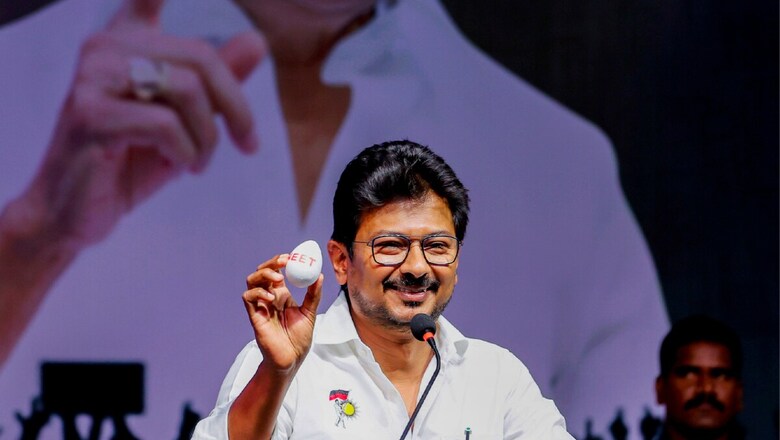
views
A few weeks ago, DMK scion Udhayanidhi Stalin submitted a plea before the Madras High Court. The Chief Minister’s son was hoping to refute the charge that he had hurt Hindu sentiments by proclaiming that Sanatana Dharma needed to be “eradicated” like “dengue, malaria, corona”.
Udhayanidhi argued that he was one of the “torch bearers of the Dravidian movement” and was keen therefore to eradicate “discriminatory religious practices” that threatened the former. Clearly, for Udhyanidhi Stalin, Sanatana Dharma is as distinct from Tamil culture as chalk is from cheese.
The arguments have, however, not found favour with the Madras High Court. The judge hearing the case said Udhayanidhi is a “person in power” and, thus, should be aware of the adverse impact of “speech unflaring (sic) fissiparous tendencies”. The High Court also slammed the police for not acting against politicians who are unable to “…restrain themselves from propagating views which will divide people in the name of ideology, caste and religion”.
The High Court’s rebuke is unlikely to chasten Stalin Junior, but it is perceptually problematic for the I.N.D.I alliance. Especially in an election season where the BJP is looking to seize any opportunity to fan Hindu insecurities.
Political analysts say that one of the reasons BJP wins is by consolidating Hindus across castes. Experts will tell you that the BJP has been able to convince many in the majority that the Opposition’s “appeasement politics” has reduced Hindus to the status of second-class citizens in their own land.
The Madras High Court’s observations castigating Udhyanidhi Stalin for his venomous hate rant against Hinduism plays straight into the BJP’s hands.
Stalin has targeted Sanatana Dharma which is a tactical mistake. He would have been far better off targeting Hindutva, at least he could have argued that he was taking on a political project that has little to do with the beliefs of crores of Indians.
But his attack on Hindu dharma – described as an eternal ancient code of ethics prescribed in the Vedas – is a direct attack on the core of Hinduism.
Stalin’s sullying of Hinduism and his ally the Congress party’s reluctance to condemn his rant provides the BJP with an opportunity to paint them as Hinduphobic in Tamil Nadu and beyond.
In fact, moments after the Madras High Court’s observations, the BJP dared the Congress to snap ties with its ally DMK if it truly respects Hindus.
But aside from the obvious political fallout, Stalin Junior’s rant and the Congress’s silence will expose a larger more insidious project that has been silently at play for decades altogether.
First, in Tamil Nadu, anti-Sanatana Dharma rhetoric was rooted in the anti-Brahminism of the Dravidian movement. From its very outset an attempt was made by the champions of Dravidian politics like the DMK to de-hyphenate Sanatana Dharma from Tamil culture.
But the truth is that Hindu Dharma is practically synonymous with Tamil culture. Stalin Junior is wrong to describe Sanatana Dharma as a blight upon Tamil culture that needs to be eradicated.
The DMK’s propensity to view Sanatana Dharma solely through the prism of caste discrimination is misplaced. The DMK is even blind to the valuable insights contained in Class XII textbooks taught in DMK-run state government schools that state “Varnashrama Dharma” doesn’t believe in caste hierarchies.
While it is true that the caste system acquired its oppressive features when the Dharmashastras were misused, the Mahabharata, for example, repudiated caste barriers. So do other ancient Hindu texts like the Bhavishya Purana.
The DMK and its leaders ignore that the greatest exponents of Sanatana Dharma were Tamils. These Tamil scholars like the legendary Sankara have written extensively on how one of the six orthodox principles of Sanatana Dharam, Advaita, transcends all differences between humans.
The DMK, to which Stalin Junior belongs, is self-admittedly the most visible political proponent of the Dravidian movement. But political experts say its anti-Brahminism is a carefully orchestrated calumny against Sanatana Dharma intended to capture the hearts of the once oppressed backward caste.
Sadly, DMK’s isn’t the only one distorting facts about Sanatana Dharma.
The second anti-Sanatana Dharma project has Nehruvian roots and centres around conveniently taking the Hindu out of the Indian.
This project with a national footprint was undertaken by “Nehruvian secularists” to suggest that India had a historical composite culture. Or, as the phrase went a “Ganga-Jamuni Tehzeeb.”
The way in which this narrative was to be grafted to obscure India’s Hindu civilizational canvas has been defined in the recommendations of the Committee on School Textbooks of the Government of India soon after Independence. One such Committee submitted its recommendation in 1969 and called for a “creative and purposeful reinterpretation of history and a judicial selection of historical truths”.
One of the facts that was subject to “judicious” editing was that Indian civilization is decidedly and pre-dominantly Hindu.
After Partition, many like Nehru felt that there was an urgent need to re-assure Muslims that had opted for India that their culture would be preserved in a Hindu majority India. Secularism thus became a by-word for decoupling the Hindu tradition from India’s larger identity.
In academics, Marxist historians set about questioning the existence of Hinduism itself. In politics, secularism was practised through appeasement. Congress governments drafted and passed laws that privileged minorities over the Hindu majority. Many executive actions were also taken to expressly undermine Hindu interests.
Moreover, any attempt by academics, political ideologues, or a political party to reclaim India’s Hindu roots was villainized as Hindutva communalism.
Voters were warned against supporting “Sanghis” championing Hindu majoritarianism. This bias against Hindu revivalists finds expression in many ways to this day.
The Madras High Court observations will certainly re-focus attention on these various acts of minority-ism. The timing couldn’t be worse for the Congress and the I.N.D.I alliance. It has less than six months to woo Hindus and thwart BJP’s saffron juggernaut.


















Comments
0 comment